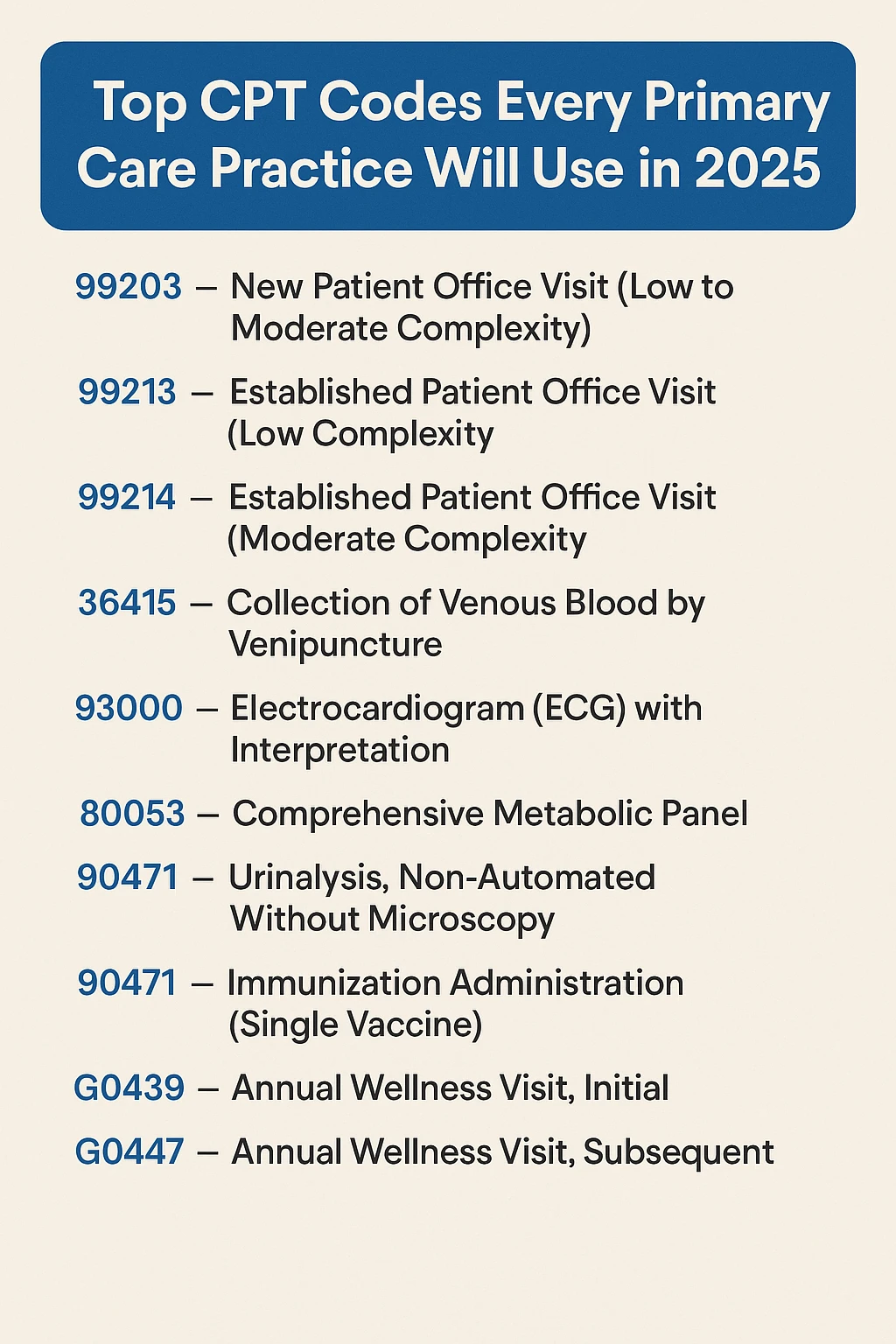Primary care practices form the backbone of healthcare. They handle everything from routine check-ups to chronic disease management. One key part of running a successful practice is accurate billing, and that starts with knowing the most common CPT (Current Procedural Terminology) codes. In 2025, certain CPT codes are used more frequently than others, and understanding these codes helps practices improve efficiency, reduce errors, and increase revenue.
What Are CPT Codes?
CPT codes are standard codes that are applied by medical practitioners to describe medical and diagnostic and surgical services. These codes help insurance companies to handle claims and reimbursement of providers. The right codes will make practices receive payments on time and will not lead to delays due to denial of claims. Poor coding can make you lose revenue, claims may be denied and unjustifiable stress to your employees.
Most primary care practices resort of medical coding services in order to ensure that all CPT codes are correct and updated. The services offer specialized coders who are knowledgeable of the rules and are able to address complicated code situations. Coding outsourcing also relieves your employees of their administrative burden so that they can be free to attend to patients.
Most Common CPT Codes in 2025
Understanding which CPT codes are most frequently used can help practices streamline their operations. Here are the top CPT codes every primary care practice will use in 2025:
- 99203 – New Patient Office Visit (Low to Moderate Complexity)
The code is applied in case a patient comes to your office and has a visit. It discusses the simple tests and assessments required in order to develop a treatment plan. - 99213 – Established Patient Office Visit (Low Complexity)
The majority of follow-ups on existing patients are covered by this code. It is applicable to the regular check-ups, minor illness, and overseeing chronic illnesses. - 99214 – Established Patient Office Visit (Moderate Complexity)
Apply this code when working with those patients that require further assessment or treatment. It is usual to have chronic disease management or various health issues. - 36415 – Collection of Venous Blood by Venipuncture
This is a very basic code that is applied to blood draws made in the office. The correct coding will guarantee that labs are billed properly. - 93000 – Electrocardiogram (ECG) with Interpretation
ECG is commonly done when there is a heart concern among the patients. The right code can assist your practice in getting out of the claim delays. - 80053 – Comprehensive Metabolic Panel
This is a regular laboratory examination that is used to keep track of the general state of a patient and identify possible complications in the early stages. - 81002 – Urinalysis, Non-Automated Without Microscopy
Urinalysis codes are a common test of most routine visits and make sure that the labs are billed and recompensed accordingly. - 90471 – Immunization Administration (Single Vaccine)
The vaccination is an imperative aspect of preventive care. This code is used whenever administering a vaccine. - G0439 – Annual Wellness Visit, Initial
Used for Medicare patients’ first annual wellness visit, this code supports preventive care and early detection. - G0447 – Annual Wellness Visit, Subsequent
Follow-up wellness visits for ongoing preventive care use this code.
How CPT Codes Improve Practice Management
Proper CPT coding isn’t just about billing—it affects your entire practice workflow. The correct coding allows you to streamline your processes and avoid errors. Primary care practices also couple coding accuracy with professional credential services for up-to-date accurate credentials, licenses, and compliance with healthcare law. Credentialing ensures providers are authorized to bill insurance companies and prevent claim denials because of lacking credentials.
Proper use of the CPT codes also has direct implications for your financial operations. Properly ar management services allow practices to track payments outstanding, pursue claims, and receive reimbursement within a reasonable timeframe. The integration of AR management and proper use of CPT codes guarantees your practice enjoys the right amount of cash flow and avoids undue financial burdens.
Denial Handling
Even with good coding, some denials will occur. Denials are frustrating, but they offer an opportunity to become more proficient in your billing process. Denial management services are applied in most primary care practices to review denied claims, identify errors, and resubmit claims appropriately. Denial management services avoid lost revenue as well as keep practices in insurance regulation compliance.
By knowing the most common CPT codes and linking them to denial management strategies, your practice will minimize delays, prevent errors from being repeated, and boost overall patient satisfaction.
Benefits of Being Current
Being up-to-date with the most common 2025 CPT codes has several benefits:
- Improves Patient Care: When administrative operations go smoothly, your staff dedicate less time to paperwork and more to patient care.
- Decreases Errors: Getting it right eliminates claim rejections and reduces losses.
- Saves Time: Staff can process claims effectively without repeatedly having to correct errors.
- Increases Revenue: Accurate billing ensures your practice is paid in full for services provided.
- Facilitates Compliance: Coupling coding with professional credential services ensures that all providers are current regarding insurance and federal compliance.
Conclusion
Primary care practice is effective if billing is accurate, efficient, and timely. Knowledge of the most commonly used 2025 CPT codes is vital to supporting your operations, reducing errors, and maximizing collections. Coupling this knowledge with medical coding services, professional credential services, AR management services, and denial management services allows practices to operate effectively, stay compliant, and do what matters most: take care of patients.
By committing to quality tools and services, your practice can be confident it can navigate the complex landscape of medical billing in 2025 and reap long-term success and financial stability.







Comments are closed